Organizational Behaviour and Leadership Report: Google's Strategies
VerifiedAdded on 2023/01/05
|18
|5589
|40
Report
AI Summary
This report provides an in-depth analysis of Google's organizational behaviour, examining the influence of its culture and power dynamics on individual and team performance. It explores various motivational theories, including content and process theories, and evaluates their application within Google to achieve organizational objectives. The report also differentiates between effective and ineffective teams, highlighting key factors contributing to team success. Furthermore, it discusses concepts and philosophies that impact behaviour within an organizational setting, offering insights into Google's strategies for fostering a positive and productive work environment. The analysis covers Google's mission, vision, values, and its adoption of various organizational culture models like Handy and Hofstede. It also examines the role of organizational politics, power dynamics, and the use of different power types, such as coercive and reward power, within Google. The report concludes by evaluating the effectiveness of Google's motivational techniques, including the application of Maslow's hierarchy of needs, Herzberg's two-factor theory, Alderfer's ERG theory, and Adam's equity theory, in driving employee engagement and achieving organizational goals.
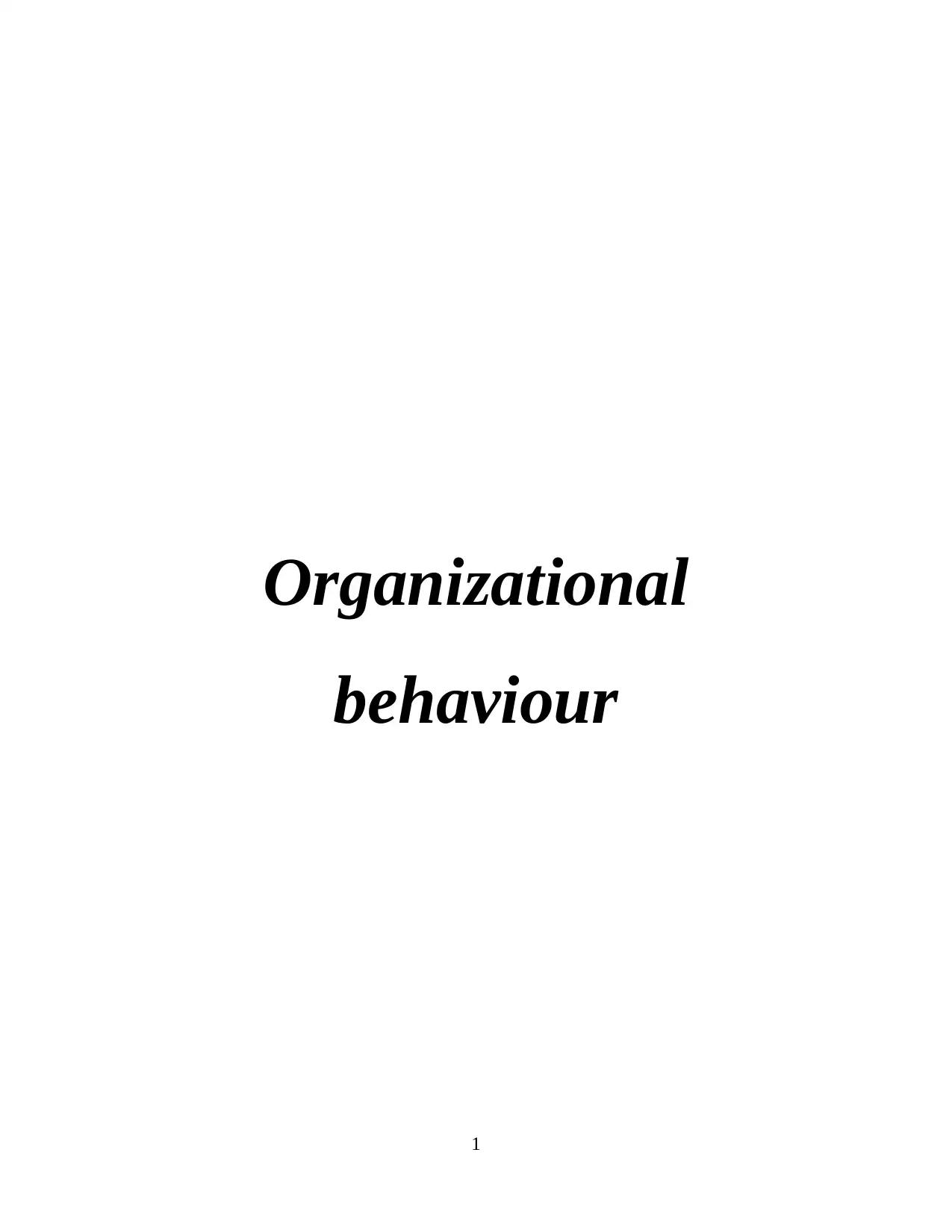
Organizational
behaviour
1
behaviour
1
Paraphrase This Document
Need a fresh take? Get an instant paraphrase of this document with our AI Paraphraser
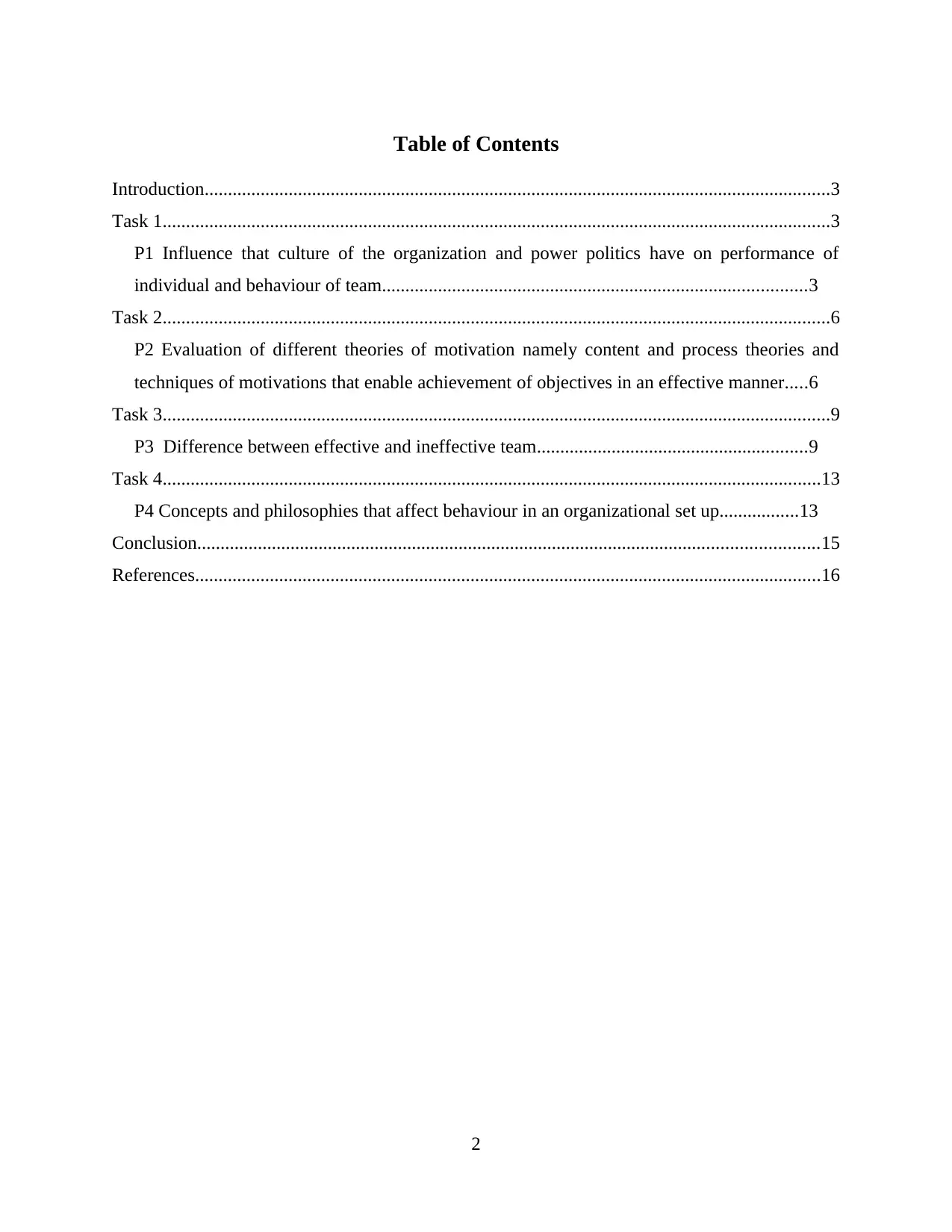
Table of Contents
Introduction......................................................................................................................................3
Task 1...............................................................................................................................................3
P1 Influence that culture of the organization and power politics have on performance of
individual and behaviour of team...........................................................................................3
Task 2...............................................................................................................................................6
P2 Evaluation of different theories of motivation namely content and process theories and
techniques of motivations that enable achievement of objectives in an effective manner.....6
Task 3...............................................................................................................................................9
P3 Difference between effective and ineffective team..........................................................9
Task 4.............................................................................................................................................13
P4 Concepts and philosophies that affect behaviour in an organizational set up.................13
Conclusion.....................................................................................................................................15
References......................................................................................................................................16
2
Introduction......................................................................................................................................3
Task 1...............................................................................................................................................3
P1 Influence that culture of the organization and power politics have on performance of
individual and behaviour of team...........................................................................................3
Task 2...............................................................................................................................................6
P2 Evaluation of different theories of motivation namely content and process theories and
techniques of motivations that enable achievement of objectives in an effective manner.....6
Task 3...............................................................................................................................................9
P3 Difference between effective and ineffective team..........................................................9
Task 4.............................................................................................................................................13
P4 Concepts and philosophies that affect behaviour in an organizational set up.................13
Conclusion.....................................................................................................................................15
References......................................................................................................................................16
2
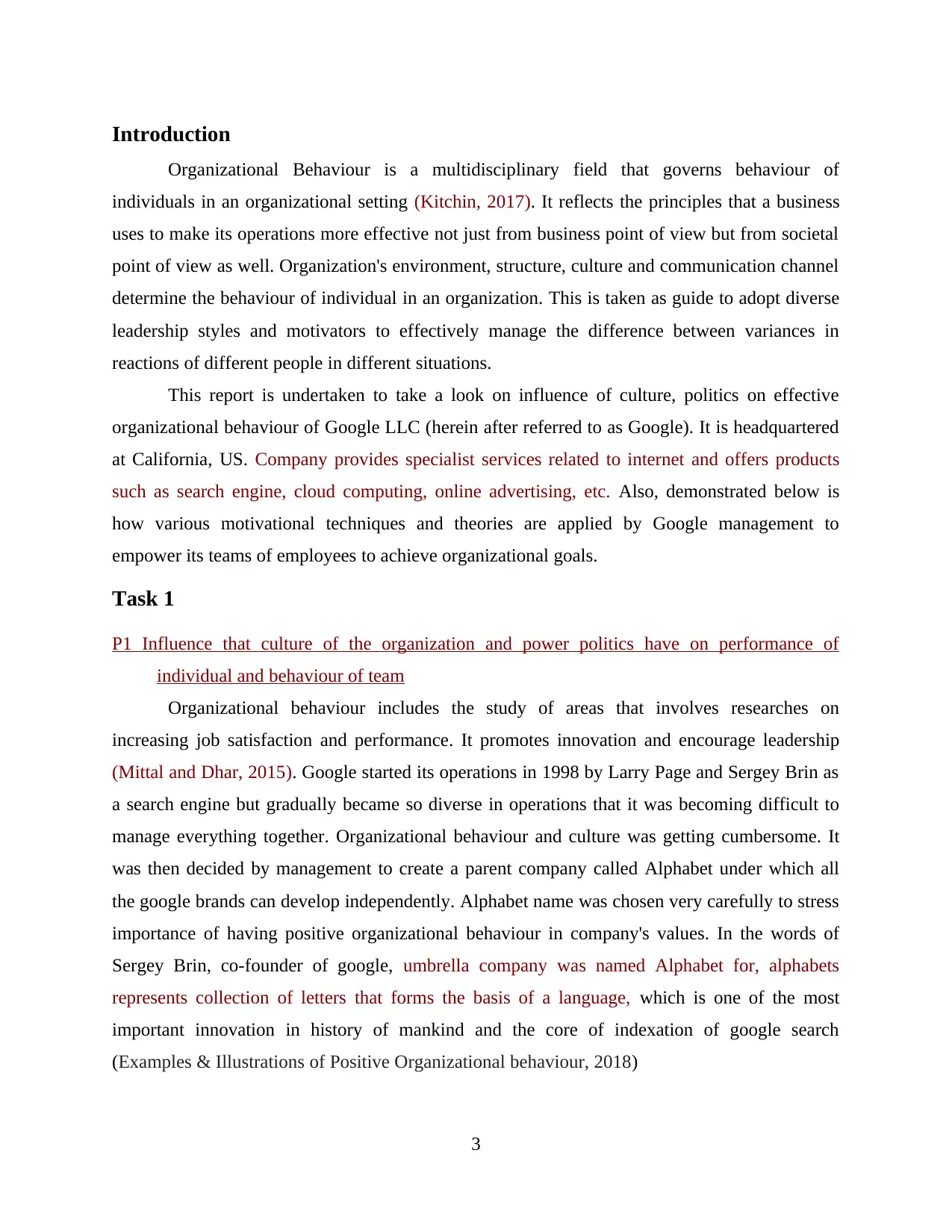
Introduction
Organizational Behaviour is a multidisciplinary field that governs behaviour of
individuals in an organizational setting (Kitchin, 2017). It reflects the principles that a business
uses to make its operations more effective not just from business point of view but from societal
point of view as well. Organization's environment, structure, culture and communication channel
determine the behaviour of individual in an organization. This is taken as guide to adopt diverse
leadership styles and motivators to effectively manage the difference between variances in
reactions of different people in different situations.
This report is undertaken to take a look on influence of culture, politics on effective
organizational behaviour of Google LLC (herein after referred to as Google). It is headquartered
at California, US. Company provides specialist services related to internet and offers products
such as search engine, cloud computing, online advertising, etc. Also, demonstrated below is
how various motivational techniques and theories are applied by Google management to
empower its teams of employees to achieve organizational goals.
Task 1
P1 Influence that culture of the organization and power politics have on performance of
individual and behaviour of team
Organizational behaviour includes the study of areas that involves researches on
increasing job satisfaction and performance. It promotes innovation and encourage leadership
(Mittal and Dhar, 2015). Google started its operations in 1998 by Larry Page and Sergey Brin as
a search engine but gradually became so diverse in operations that it was becoming difficult to
manage everything together. Organizational behaviour and culture was getting cumbersome. It
was then decided by management to create a parent company called Alphabet under which all
the google brands can develop independently. Alphabet name was chosen very carefully to stress
importance of having positive organizational behaviour in company's values. In the words of
Sergey Brin, co-founder of google, umbrella company was named Alphabet for, alphabets
represents collection of letters that forms the basis of a language, which is one of the most
important innovation in history of mankind and the core of indexation of google search
(Examples & Illustrations of Positive Organizational behaviour, 2018)
3
Organizational Behaviour is a multidisciplinary field that governs behaviour of
individuals in an organizational setting (Kitchin, 2017). It reflects the principles that a business
uses to make its operations more effective not just from business point of view but from societal
point of view as well. Organization's environment, structure, culture and communication channel
determine the behaviour of individual in an organization. This is taken as guide to adopt diverse
leadership styles and motivators to effectively manage the difference between variances in
reactions of different people in different situations.
This report is undertaken to take a look on influence of culture, politics on effective
organizational behaviour of Google LLC (herein after referred to as Google). It is headquartered
at California, US. Company provides specialist services related to internet and offers products
such as search engine, cloud computing, online advertising, etc. Also, demonstrated below is
how various motivational techniques and theories are applied by Google management to
empower its teams of employees to achieve organizational goals.
Task 1
P1 Influence that culture of the organization and power politics have on performance of
individual and behaviour of team
Organizational behaviour includes the study of areas that involves researches on
increasing job satisfaction and performance. It promotes innovation and encourage leadership
(Mittal and Dhar, 2015). Google started its operations in 1998 by Larry Page and Sergey Brin as
a search engine but gradually became so diverse in operations that it was becoming difficult to
manage everything together. Organizational behaviour and culture was getting cumbersome. It
was then decided by management to create a parent company called Alphabet under which all
the google brands can develop independently. Alphabet name was chosen very carefully to stress
importance of having positive organizational behaviour in company's values. In the words of
Sergey Brin, co-founder of google, umbrella company was named Alphabet for, alphabets
represents collection of letters that forms the basis of a language, which is one of the most
important innovation in history of mankind and the core of indexation of google search
(Examples & Illustrations of Positive Organizational behaviour, 2018)
3
⊘ This is a preview!⊘
Do you want full access?
Subscribe today to unlock all pages.

Trusted by 1+ million students worldwide
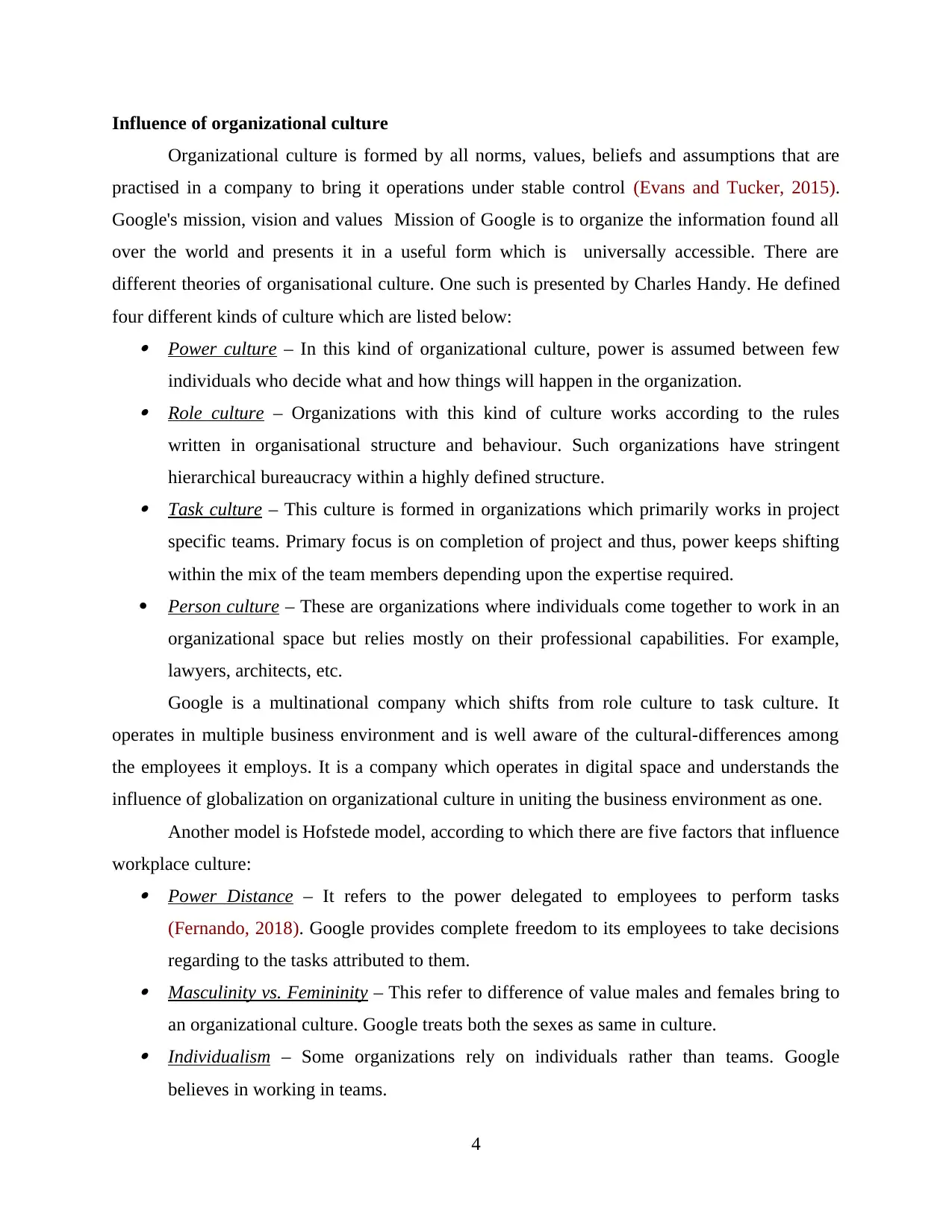
Influence of organizational culture
Organizational culture is formed by all norms, values, beliefs and assumptions that are
practised in a company to bring it operations under stable control (Evans and Tucker, 2015).
Google's mission, vision and values Mission of Google is to organize the information found all
over the world and presents it in a useful form which is universally accessible. There are
different theories of organisational culture. One such is presented by Charles Handy. He defined
four different kinds of culture which are listed below: Power culture – In this kind of organizational culture, power is assumed between few
individuals who decide what and how things will happen in the organization. Role culture – Organizations with this kind of culture works according to the rules
written in organisational structure and behaviour. Such organizations have stringent
hierarchical bureaucracy within a highly defined structure. Task culture – This culture is formed in organizations which primarily works in project
specific teams. Primary focus is on completion of project and thus, power keeps shifting
within the mix of the team members depending upon the expertise required.
Person culture – These are organizations where individuals come together to work in an
organizational space but relies mostly on their professional capabilities. For example,
lawyers, architects, etc.
Google is a multinational company which shifts from role culture to task culture. It
operates in multiple business environment and is well aware of the cultural-differences among
the employees it employs. It is a company which operates in digital space and understands the
influence of globalization on organizational culture in uniting the business environment as one.
Another model is Hofstede model, according to which there are five factors that influence
workplace culture: Power Distance – It refers to the power delegated to employees to perform tasks
(Fernando, 2018). Google provides complete freedom to its employees to take decisions
regarding to the tasks attributed to them. Masculinity vs. Femininity – This refer to difference of value males and females bring to
an organizational culture. Google treats both the sexes as same in culture. Individualism – Some organizations rely on individuals rather than teams. Google
believes in working in teams.
4
Organizational culture is formed by all norms, values, beliefs and assumptions that are
practised in a company to bring it operations under stable control (Evans and Tucker, 2015).
Google's mission, vision and values Mission of Google is to organize the information found all
over the world and presents it in a useful form which is universally accessible. There are
different theories of organisational culture. One such is presented by Charles Handy. He defined
four different kinds of culture which are listed below: Power culture – In this kind of organizational culture, power is assumed between few
individuals who decide what and how things will happen in the organization. Role culture – Organizations with this kind of culture works according to the rules
written in organisational structure and behaviour. Such organizations have stringent
hierarchical bureaucracy within a highly defined structure. Task culture – This culture is formed in organizations which primarily works in project
specific teams. Primary focus is on completion of project and thus, power keeps shifting
within the mix of the team members depending upon the expertise required.
Person culture – These are organizations where individuals come together to work in an
organizational space but relies mostly on their professional capabilities. For example,
lawyers, architects, etc.
Google is a multinational company which shifts from role culture to task culture. It
operates in multiple business environment and is well aware of the cultural-differences among
the employees it employs. It is a company which operates in digital space and understands the
influence of globalization on organizational culture in uniting the business environment as one.
Another model is Hofstede model, according to which there are five factors that influence
workplace culture: Power Distance – It refers to the power delegated to employees to perform tasks
(Fernando, 2018). Google provides complete freedom to its employees to take decisions
regarding to the tasks attributed to them. Masculinity vs. Femininity – This refer to difference of value males and females bring to
an organizational culture. Google treats both the sexes as same in culture. Individualism – Some organizations rely on individuals rather than teams. Google
believes in working in teams.
4
Paraphrase This Document
Need a fresh take? Get an instant paraphrase of this document with our AI Paraphraser
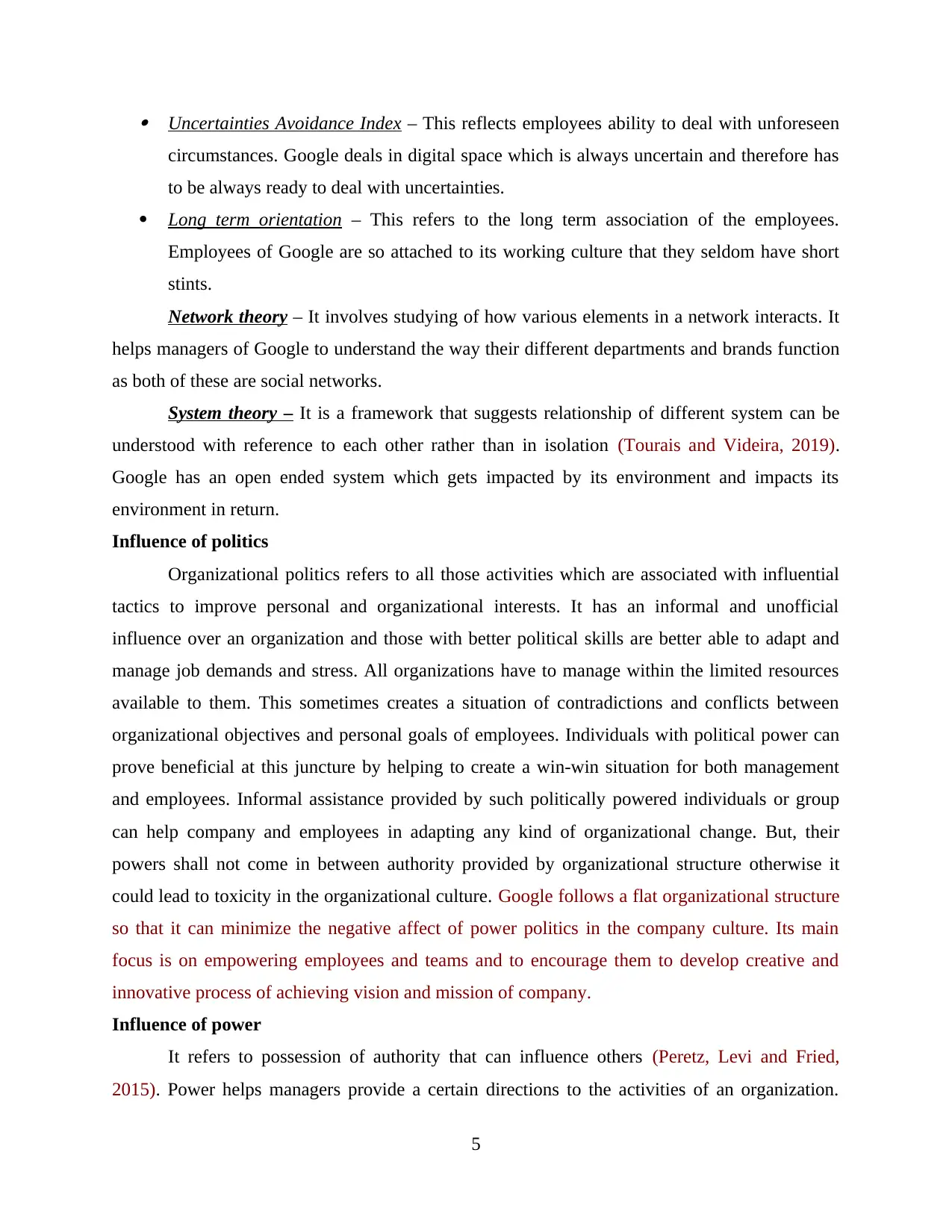
Uncertainties Avoidance Index – This reflects employees ability to deal with unforeseen
circumstances. Google deals in digital space which is always uncertain and therefore has
to be always ready to deal with uncertainties.
Long term orientation – This refers to the long term association of the employees.
Employees of Google are so attached to its working culture that they seldom have short
stints.
Network theory – It involves studying of how various elements in a network interacts. It
helps managers of Google to understand the way their different departments and brands function
as both of these are social networks.
System theory – It is a framework that suggests relationship of different system can be
understood with reference to each other rather than in isolation (Tourais and Videira, 2019).
Google has an open ended system which gets impacted by its environment and impacts its
environment in return.
Influence of politics
Organizational politics refers to all those activities which are associated with influential
tactics to improve personal and organizational interests. It has an informal and unofficial
influence over an organization and those with better political skills are better able to adapt and
manage job demands and stress. All organizations have to manage within the limited resources
available to them. This sometimes creates a situation of contradictions and conflicts between
organizational objectives and personal goals of employees. Individuals with political power can
prove beneficial at this juncture by helping to create a win-win situation for both management
and employees. Informal assistance provided by such politically powered individuals or group
can help company and employees in adapting any kind of organizational change. But, their
powers shall not come in between authority provided by organizational structure otherwise it
could lead to toxicity in the organizational culture. Google follows a flat organizational structure
so that it can minimize the negative affect of power politics in the company culture. Its main
focus is on empowering employees and teams and to encourage them to develop creative and
innovative process of achieving vision and mission of company.
Influence of power
It refers to possession of authority that can influence others (Peretz, Levi and Fried,
2015). Power helps managers provide a certain directions to the activities of an organization.
5
circumstances. Google deals in digital space which is always uncertain and therefore has
to be always ready to deal with uncertainties.
Long term orientation – This refers to the long term association of the employees.
Employees of Google are so attached to its working culture that they seldom have short
stints.
Network theory – It involves studying of how various elements in a network interacts. It
helps managers of Google to understand the way their different departments and brands function
as both of these are social networks.
System theory – It is a framework that suggests relationship of different system can be
understood with reference to each other rather than in isolation (Tourais and Videira, 2019).
Google has an open ended system which gets impacted by its environment and impacts its
environment in return.
Influence of politics
Organizational politics refers to all those activities which are associated with influential
tactics to improve personal and organizational interests. It has an informal and unofficial
influence over an organization and those with better political skills are better able to adapt and
manage job demands and stress. All organizations have to manage within the limited resources
available to them. This sometimes creates a situation of contradictions and conflicts between
organizational objectives and personal goals of employees. Individuals with political power can
prove beneficial at this juncture by helping to create a win-win situation for both management
and employees. Informal assistance provided by such politically powered individuals or group
can help company and employees in adapting any kind of organizational change. But, their
powers shall not come in between authority provided by organizational structure otherwise it
could lead to toxicity in the organizational culture. Google follows a flat organizational structure
so that it can minimize the negative affect of power politics in the company culture. Its main
focus is on empowering employees and teams and to encourage them to develop creative and
innovative process of achieving vision and mission of company.
Influence of power
It refers to possession of authority that can influence others (Peretz, Levi and Fried,
2015). Power helps managers provide a certain directions to the activities of an organization.
5
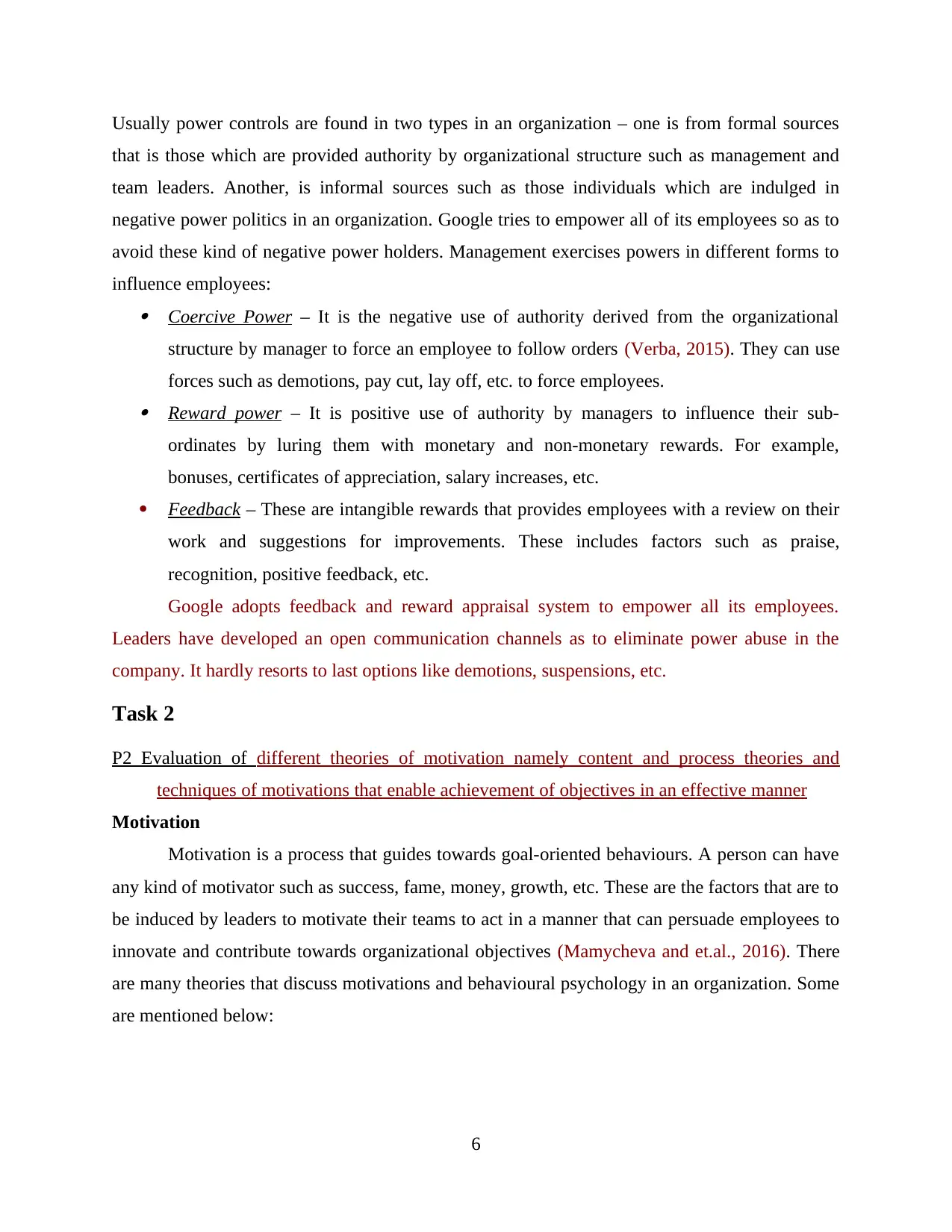
Usually power controls are found in two types in an organization – one is from formal sources
that is those which are provided authority by organizational structure such as management and
team leaders. Another, is informal sources such as those individuals which are indulged in
negative power politics in an organization. Google tries to empower all of its employees so as to
avoid these kind of negative power holders. Management exercises powers in different forms to
influence employees: Coercive Power – It is the negative use of authority derived from the organizational
structure by manager to force an employee to follow orders (Verba, 2015). They can use
forces such as demotions, pay cut, lay off, etc. to force employees. Reward power – It is positive use of authority by managers to influence their sub-
ordinates by luring them with monetary and non-monetary rewards. For example,
bonuses, certificates of appreciation, salary increases, etc.
Feedback – These are intangible rewards that provides employees with a review on their
work and suggestions for improvements. These includes factors such as praise,
recognition, positive feedback, etc.
Google adopts feedback and reward appraisal system to empower all its employees.
Leaders have developed an open communication channels as to eliminate power abuse in the
company. It hardly resorts to last options like demotions, suspensions, etc.
Task 2
P2 Evaluation of different theories of motivation namely content and process theories and
techniques of motivations that enable achievement of objectives in an effective manner
Motivation
Motivation is a process that guides towards goal-oriented behaviours. A person can have
any kind of motivator such as success, fame, money, growth, etc. These are the factors that are to
be induced by leaders to motivate their teams to act in a manner that can persuade employees to
innovate and contribute towards organizational objectives (Mamycheva and et.al., 2016). There
are many theories that discuss motivations and behavioural psychology in an organization. Some
are mentioned below:
6
that is those which are provided authority by organizational structure such as management and
team leaders. Another, is informal sources such as those individuals which are indulged in
negative power politics in an organization. Google tries to empower all of its employees so as to
avoid these kind of negative power holders. Management exercises powers in different forms to
influence employees: Coercive Power – It is the negative use of authority derived from the organizational
structure by manager to force an employee to follow orders (Verba, 2015). They can use
forces such as demotions, pay cut, lay off, etc. to force employees. Reward power – It is positive use of authority by managers to influence their sub-
ordinates by luring them with monetary and non-monetary rewards. For example,
bonuses, certificates of appreciation, salary increases, etc.
Feedback – These are intangible rewards that provides employees with a review on their
work and suggestions for improvements. These includes factors such as praise,
recognition, positive feedback, etc.
Google adopts feedback and reward appraisal system to empower all its employees.
Leaders have developed an open communication channels as to eliminate power abuse in the
company. It hardly resorts to last options like demotions, suspensions, etc.
Task 2
P2 Evaluation of different theories of motivation namely content and process theories and
techniques of motivations that enable achievement of objectives in an effective manner
Motivation
Motivation is a process that guides towards goal-oriented behaviours. A person can have
any kind of motivator such as success, fame, money, growth, etc. These are the factors that are to
be induced by leaders to motivate their teams to act in a manner that can persuade employees to
innovate and contribute towards organizational objectives (Mamycheva and et.al., 2016). There
are many theories that discuss motivations and behavioural psychology in an organization. Some
are mentioned below:
6
⊘ This is a preview!⊘
Do you want full access?
Subscribe today to unlock all pages.

Trusted by 1+ million students worldwide
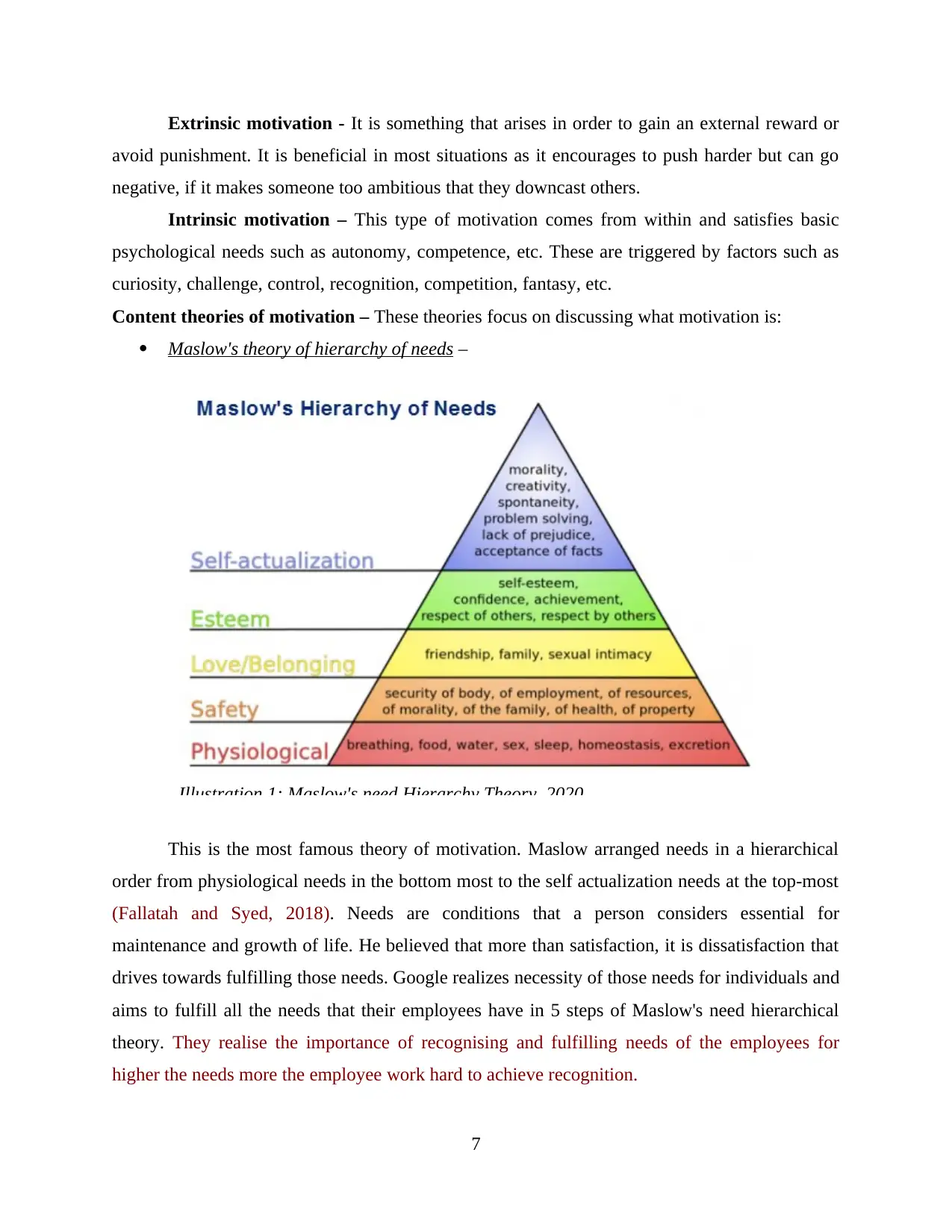
Extrinsic motivation - It is something that arises in order to gain an external reward or
avoid punishment. It is beneficial in most situations as it encourages to push harder but can go
negative, if it makes someone too ambitious that they downcast others.
Intrinsic motivation – This type of motivation comes from within and satisfies basic
psychological needs such as autonomy, competence, etc. These are triggered by factors such as
curiosity, challenge, control, recognition, competition, fantasy, etc.
Content theories of motivation – These theories focus on discussing what motivation is:
Maslow's theory of hierarchy of needs –
This is the most famous theory of motivation. Maslow arranged needs in a hierarchical
order from physiological needs in the bottom most to the self actualization needs at the top-most
(Fallatah and Syed, 2018). Needs are conditions that a person considers essential for
maintenance and growth of life. He believed that more than satisfaction, it is dissatisfaction that
drives towards fulfilling those needs. Google realizes necessity of those needs for individuals and
aims to fulfill all the needs that their employees have in 5 steps of Maslow's need hierarchical
theory. They realise the importance of recognising and fulfilling needs of the employees for
higher the needs more the employee work hard to achieve recognition.
7
Illustration 1: Maslow's need Hierarchy Theory, 2020
avoid punishment. It is beneficial in most situations as it encourages to push harder but can go
negative, if it makes someone too ambitious that they downcast others.
Intrinsic motivation – This type of motivation comes from within and satisfies basic
psychological needs such as autonomy, competence, etc. These are triggered by factors such as
curiosity, challenge, control, recognition, competition, fantasy, etc.
Content theories of motivation – These theories focus on discussing what motivation is:
Maslow's theory of hierarchy of needs –
This is the most famous theory of motivation. Maslow arranged needs in a hierarchical
order from physiological needs in the bottom most to the self actualization needs at the top-most
(Fallatah and Syed, 2018). Needs are conditions that a person considers essential for
maintenance and growth of life. He believed that more than satisfaction, it is dissatisfaction that
drives towards fulfilling those needs. Google realizes necessity of those needs for individuals and
aims to fulfill all the needs that their employees have in 5 steps of Maslow's need hierarchical
theory. They realise the importance of recognising and fulfilling needs of the employees for
higher the needs more the employee work hard to achieve recognition.
7
Illustration 1: Maslow's need Hierarchy Theory, 2020
Paraphrase This Document
Need a fresh take? Get an instant paraphrase of this document with our AI Paraphraser
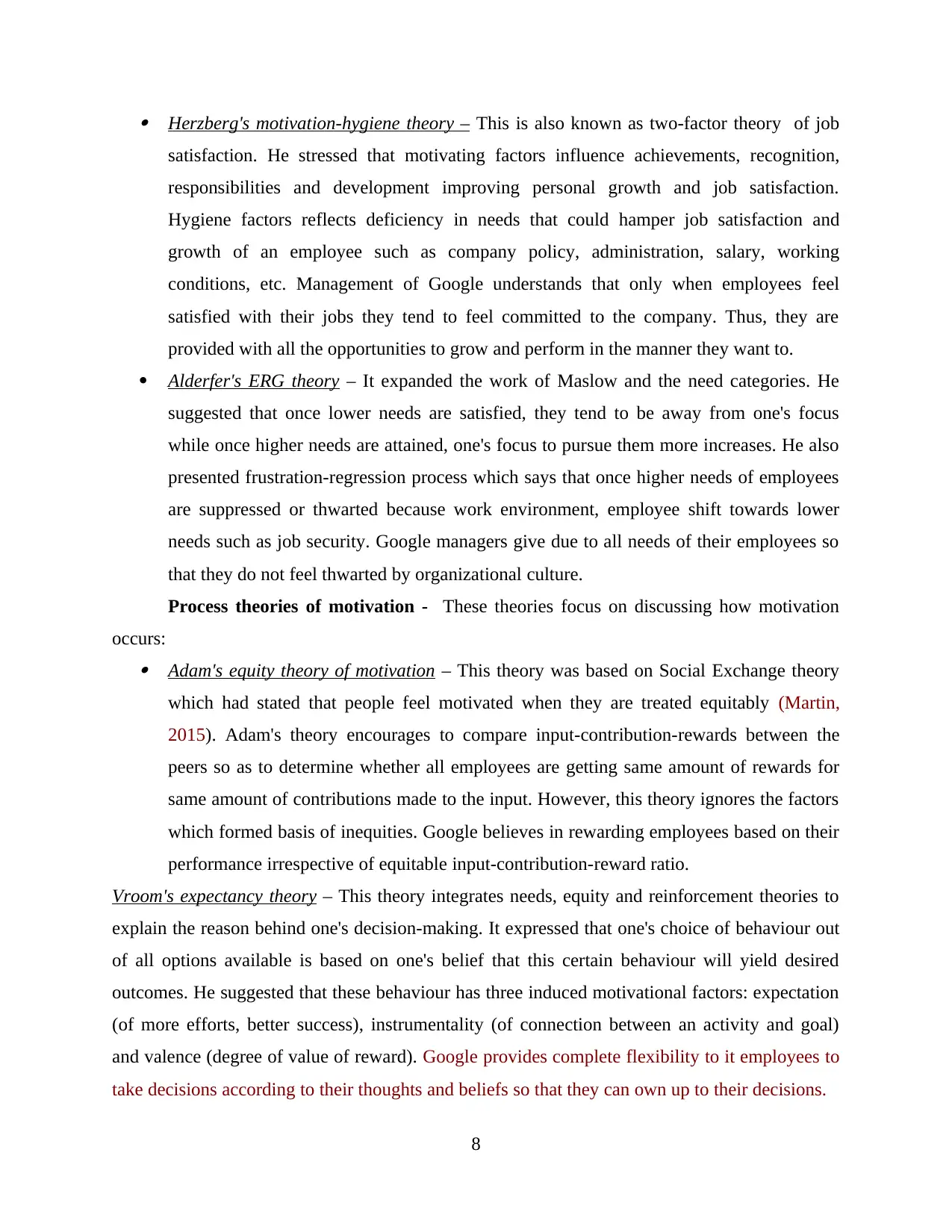
Herzberg's motivation-hygiene theory – This is also known as two-factor theory of job
satisfaction. He stressed that motivating factors influence achievements, recognition,
responsibilities and development improving personal growth and job satisfaction.
Hygiene factors reflects deficiency in needs that could hamper job satisfaction and
growth of an employee such as company policy, administration, salary, working
conditions, etc. Management of Google understands that only when employees feel
satisfied with their jobs they tend to feel committed to the company. Thus, they are
provided with all the opportunities to grow and perform in the manner they want to.
Alderfer's ERG theory – It expanded the work of Maslow and the need categories. He
suggested that once lower needs are satisfied, they tend to be away from one's focus
while once higher needs are attained, one's focus to pursue them more increases. He also
presented frustration-regression process which says that once higher needs of employees
are suppressed or thwarted because work environment, employee shift towards lower
needs such as job security. Google managers give due to all needs of their employees so
that they do not feel thwarted by organizational culture.
Process theories of motivation - These theories focus on discussing how motivation
occurs: Adam's equity theory of motivation – This theory was based on Social Exchange theory
which had stated that people feel motivated when they are treated equitably (Martin,
2015). Adam's theory encourages to compare input-contribution-rewards between the
peers so as to determine whether all employees are getting same amount of rewards for
same amount of contributions made to the input. However, this theory ignores the factors
which formed basis of inequities. Google believes in rewarding employees based on their
performance irrespective of equitable input-contribution-reward ratio.
Vroom's expectancy theory – This theory integrates needs, equity and reinforcement theories to
explain the reason behind one's decision-making. It expressed that one's choice of behaviour out
of all options available is based on one's belief that this certain behaviour will yield desired
outcomes. He suggested that these behaviour has three induced motivational factors: expectation
(of more efforts, better success), instrumentality (of connection between an activity and goal)
and valence (degree of value of reward). Google provides complete flexibility to it employees to
take decisions according to their thoughts and beliefs so that they can own up to their decisions.
8
satisfaction. He stressed that motivating factors influence achievements, recognition,
responsibilities and development improving personal growth and job satisfaction.
Hygiene factors reflects deficiency in needs that could hamper job satisfaction and
growth of an employee such as company policy, administration, salary, working
conditions, etc. Management of Google understands that only when employees feel
satisfied with their jobs they tend to feel committed to the company. Thus, they are
provided with all the opportunities to grow and perform in the manner they want to.
Alderfer's ERG theory – It expanded the work of Maslow and the need categories. He
suggested that once lower needs are satisfied, they tend to be away from one's focus
while once higher needs are attained, one's focus to pursue them more increases. He also
presented frustration-regression process which says that once higher needs of employees
are suppressed or thwarted because work environment, employee shift towards lower
needs such as job security. Google managers give due to all needs of their employees so
that they do not feel thwarted by organizational culture.
Process theories of motivation - These theories focus on discussing how motivation
occurs: Adam's equity theory of motivation – This theory was based on Social Exchange theory
which had stated that people feel motivated when they are treated equitably (Martin,
2015). Adam's theory encourages to compare input-contribution-rewards between the
peers so as to determine whether all employees are getting same amount of rewards for
same amount of contributions made to the input. However, this theory ignores the factors
which formed basis of inequities. Google believes in rewarding employees based on their
performance irrespective of equitable input-contribution-reward ratio.
Vroom's expectancy theory – This theory integrates needs, equity and reinforcement theories to
explain the reason behind one's decision-making. It expressed that one's choice of behaviour out
of all options available is based on one's belief that this certain behaviour will yield desired
outcomes. He suggested that these behaviour has three induced motivational factors: expectation
(of more efforts, better success), instrumentality (of connection between an activity and goal)
and valence (degree of value of reward). Google provides complete flexibility to it employees to
take decisions according to their thoughts and beliefs so that they can own up to their decisions.
8
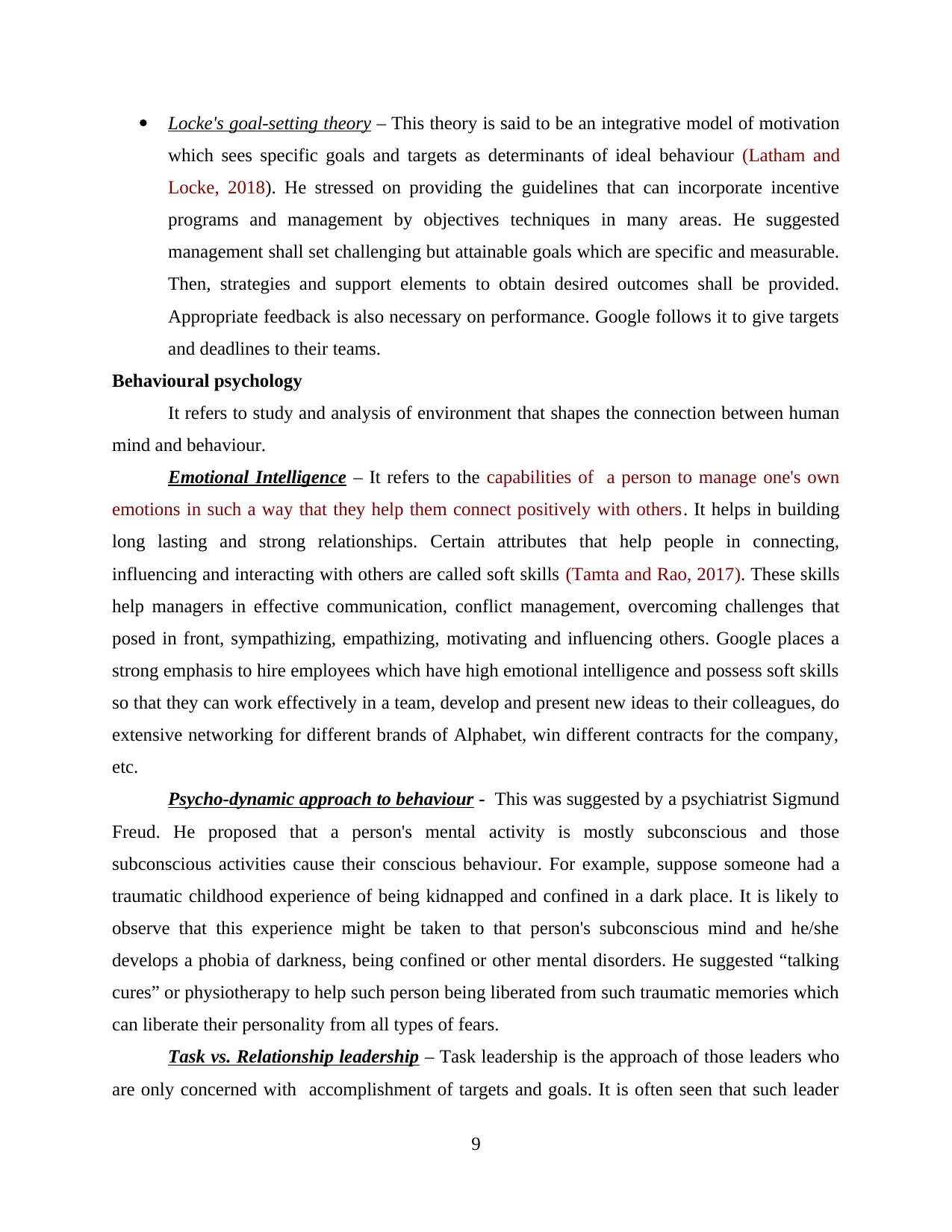
Locke's goal-setting theory – This theory is said to be an integrative model of motivation
which sees specific goals and targets as determinants of ideal behaviour (Latham and
Locke, 2018). He stressed on providing the guidelines that can incorporate incentive
programs and management by objectives techniques in many areas. He suggested
management shall set challenging but attainable goals which are specific and measurable.
Then, strategies and support elements to obtain desired outcomes shall be provided.
Appropriate feedback is also necessary on performance. Google follows it to give targets
and deadlines to their teams.
Behavioural psychology
It refers to study and analysis of environment that shapes the connection between human
mind and behaviour.
Emotional Intelligence – It refers to the capabilities of a person to manage one's own
emotions in such a way that they help them connect positively with others. It helps in building
long lasting and strong relationships. Certain attributes that help people in connecting,
influencing and interacting with others are called soft skills (Tamta and Rao, 2017). These skills
help managers in effective communication, conflict management, overcoming challenges that
posed in front, sympathizing, empathizing, motivating and influencing others. Google places a
strong emphasis to hire employees which have high emotional intelligence and possess soft skills
so that they can work effectively in a team, develop and present new ideas to their colleagues, do
extensive networking for different brands of Alphabet, win different contracts for the company,
etc.
Psycho-dynamic approach to behaviour - This was suggested by a psychiatrist Sigmund
Freud. He proposed that a person's mental activity is mostly subconscious and those
subconscious activities cause their conscious behaviour. For example, suppose someone had a
traumatic childhood experience of being kidnapped and confined in a dark place. It is likely to
observe that this experience might be taken to that person's subconscious mind and he/she
develops a phobia of darkness, being confined or other mental disorders. He suggested “talking
cures” or physiotherapy to help such person being liberated from such traumatic memories which
can liberate their personality from all types of fears.
Task vs. Relationship leadership – Task leadership is the approach of those leaders who
are only concerned with accomplishment of targets and goals. It is often seen that such leader
9
which sees specific goals and targets as determinants of ideal behaviour (Latham and
Locke, 2018). He stressed on providing the guidelines that can incorporate incentive
programs and management by objectives techniques in many areas. He suggested
management shall set challenging but attainable goals which are specific and measurable.
Then, strategies and support elements to obtain desired outcomes shall be provided.
Appropriate feedback is also necessary on performance. Google follows it to give targets
and deadlines to their teams.
Behavioural psychology
It refers to study and analysis of environment that shapes the connection between human
mind and behaviour.
Emotional Intelligence – It refers to the capabilities of a person to manage one's own
emotions in such a way that they help them connect positively with others. It helps in building
long lasting and strong relationships. Certain attributes that help people in connecting,
influencing and interacting with others are called soft skills (Tamta and Rao, 2017). These skills
help managers in effective communication, conflict management, overcoming challenges that
posed in front, sympathizing, empathizing, motivating and influencing others. Google places a
strong emphasis to hire employees which have high emotional intelligence and possess soft skills
so that they can work effectively in a team, develop and present new ideas to their colleagues, do
extensive networking for different brands of Alphabet, win different contracts for the company,
etc.
Psycho-dynamic approach to behaviour - This was suggested by a psychiatrist Sigmund
Freud. He proposed that a person's mental activity is mostly subconscious and those
subconscious activities cause their conscious behaviour. For example, suppose someone had a
traumatic childhood experience of being kidnapped and confined in a dark place. It is likely to
observe that this experience might be taken to that person's subconscious mind and he/she
develops a phobia of darkness, being confined or other mental disorders. He suggested “talking
cures” or physiotherapy to help such person being liberated from such traumatic memories which
can liberate their personality from all types of fears.
Task vs. Relationship leadership – Task leadership is the approach of those leaders who
are only concerned with accomplishment of targets and goals. It is often seen that such leader
9
⊘ This is a preview!⊘
Do you want full access?
Subscribe today to unlock all pages.

Trusted by 1+ million students worldwide
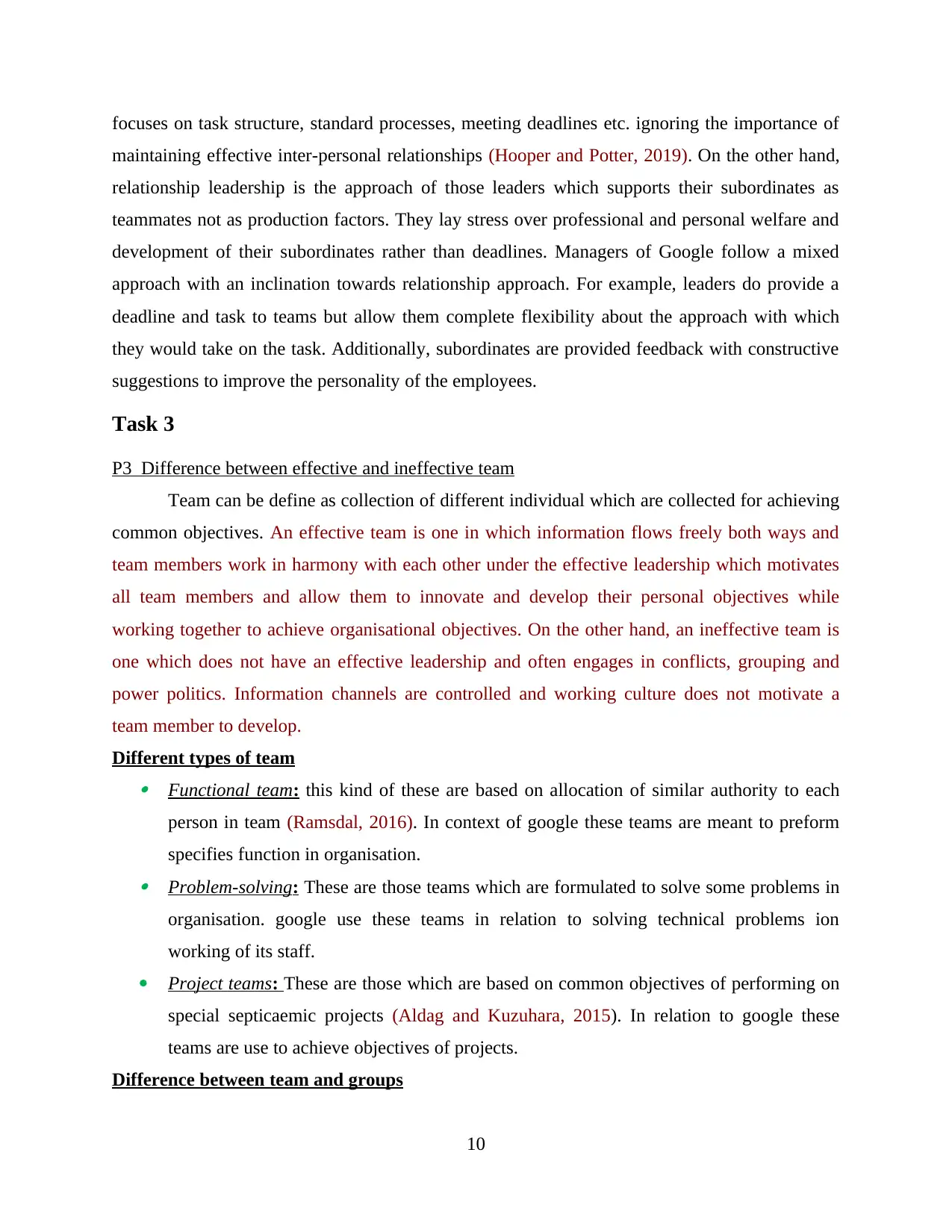
focuses on task structure, standard processes, meeting deadlines etc. ignoring the importance of
maintaining effective inter-personal relationships (Hooper and Potter, 2019). On the other hand,
relationship leadership is the approach of those leaders which supports their subordinates as
teammates not as production factors. They lay stress over professional and personal welfare and
development of their subordinates rather than deadlines. Managers of Google follow a mixed
approach with an inclination towards relationship approach. For example, leaders do provide a
deadline and task to teams but allow them complete flexibility about the approach with which
they would take on the task. Additionally, subordinates are provided feedback with constructive
suggestions to improve the personality of the employees.
Task 3
P3 Difference between effective and ineffective team
Team can be define as collection of different individual which are collected for achieving
common objectives. An effective team is one in which information flows freely both ways and
team members work in harmony with each other under the effective leadership which motivates
all team members and allow them to innovate and develop their personal objectives while
working together to achieve organisational objectives. On the other hand, an ineffective team is
one which does not have an effective leadership and often engages in conflicts, grouping and
power politics. Information channels are controlled and working culture does not motivate a
team member to develop.
Different types of team Functional team: this kind of these are based on allocation of similar authority to each
person in team (Ramsdal, 2016). In context of google these teams are meant to preform
specifies function in organisation. Problem-solving: These are those teams which are formulated to solve some problems in
organisation. google use these teams in relation to solving technical problems ion
working of its staff.
Project teams: These are those which are based on common objectives of performing on
special septicaemic projects (Aldag and Kuzuhara, 2015). In relation to google these
teams are use to achieve objectives of projects.
Difference between team and groups
10
maintaining effective inter-personal relationships (Hooper and Potter, 2019). On the other hand,
relationship leadership is the approach of those leaders which supports their subordinates as
teammates not as production factors. They lay stress over professional and personal welfare and
development of their subordinates rather than deadlines. Managers of Google follow a mixed
approach with an inclination towards relationship approach. For example, leaders do provide a
deadline and task to teams but allow them complete flexibility about the approach with which
they would take on the task. Additionally, subordinates are provided feedback with constructive
suggestions to improve the personality of the employees.
Task 3
P3 Difference between effective and ineffective team
Team can be define as collection of different individual which are collected for achieving
common objectives. An effective team is one in which information flows freely both ways and
team members work in harmony with each other under the effective leadership which motivates
all team members and allow them to innovate and develop their personal objectives while
working together to achieve organisational objectives. On the other hand, an ineffective team is
one which does not have an effective leadership and often engages in conflicts, grouping and
power politics. Information channels are controlled and working culture does not motivate a
team member to develop.
Different types of team Functional team: this kind of these are based on allocation of similar authority to each
person in team (Ramsdal, 2016). In context of google these teams are meant to preform
specifies function in organisation. Problem-solving: These are those teams which are formulated to solve some problems in
organisation. google use these teams in relation to solving technical problems ion
working of its staff.
Project teams: These are those which are based on common objectives of performing on
special septicaemic projects (Aldag and Kuzuhara, 2015). In relation to google these
teams are use to achieve objectives of projects.
Difference between team and groups
10
Paraphrase This Document
Need a fresh take? Get an instant paraphrase of this document with our AI Paraphraser
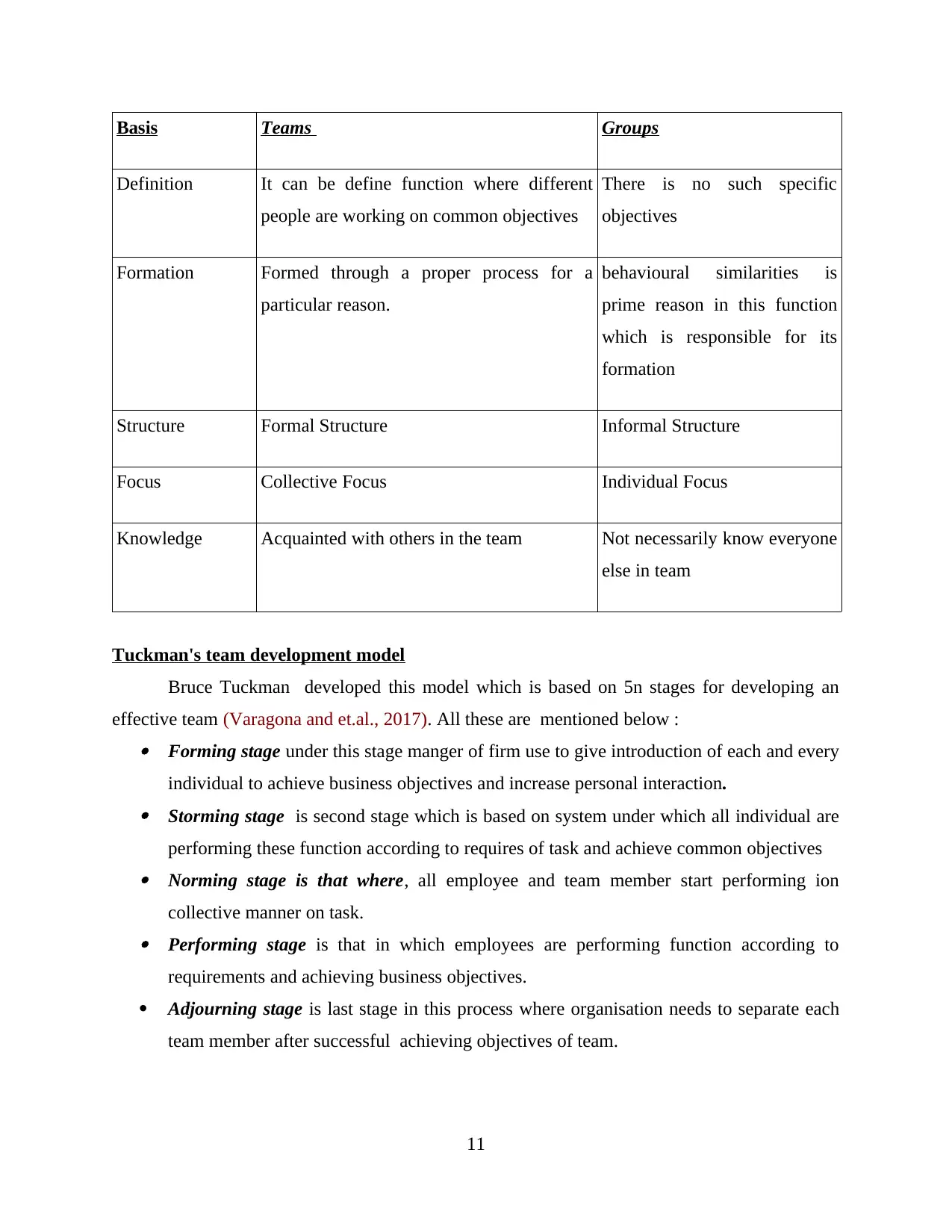
Basis Teams Groups
Definition It can be define function where different
people are working on common objectives
There is no such specific
objectives
Formation Formed through a proper process for a
particular reason.
behavioural similarities is
prime reason in this function
which is responsible for its
formation
Structure Formal Structure Informal Structure
Focus Collective Focus Individual Focus
Knowledge Acquainted with others in the team Not necessarily know everyone
else in team
Tuckman's team development model
Bruce Tuckman developed this model which is based on 5n stages for developing an
effective team (Varagona and et.al., 2017). All these are mentioned below : Forming stage under this stage manger of firm use to give introduction of each and every
individual to achieve business objectives and increase personal interaction. Storming stage is second stage which is based on system under which all individual are
performing these function according to requires of task and achieve common objectives Norming stage is that where, all employee and team member start performing ion
collective manner on task. Performing stage is that in which employees are performing function according to
requirements and achieving business objectives.
Adjourning stage is last stage in this process where organisation needs to separate each
team member after successful achieving objectives of team.
11
Definition It can be define function where different
people are working on common objectives
There is no such specific
objectives
Formation Formed through a proper process for a
particular reason.
behavioural similarities is
prime reason in this function
which is responsible for its
formation
Structure Formal Structure Informal Structure
Focus Collective Focus Individual Focus
Knowledge Acquainted with others in the team Not necessarily know everyone
else in team
Tuckman's team development model
Bruce Tuckman developed this model which is based on 5n stages for developing an
effective team (Varagona and et.al., 2017). All these are mentioned below : Forming stage under this stage manger of firm use to give introduction of each and every
individual to achieve business objectives and increase personal interaction. Storming stage is second stage which is based on system under which all individual are
performing these function according to requires of task and achieve common objectives Norming stage is that where, all employee and team member start performing ion
collective manner on task. Performing stage is that in which employees are performing function according to
requirements and achieving business objectives.
Adjourning stage is last stage in this process where organisation needs to separate each
team member after successful achieving objectives of team.
11
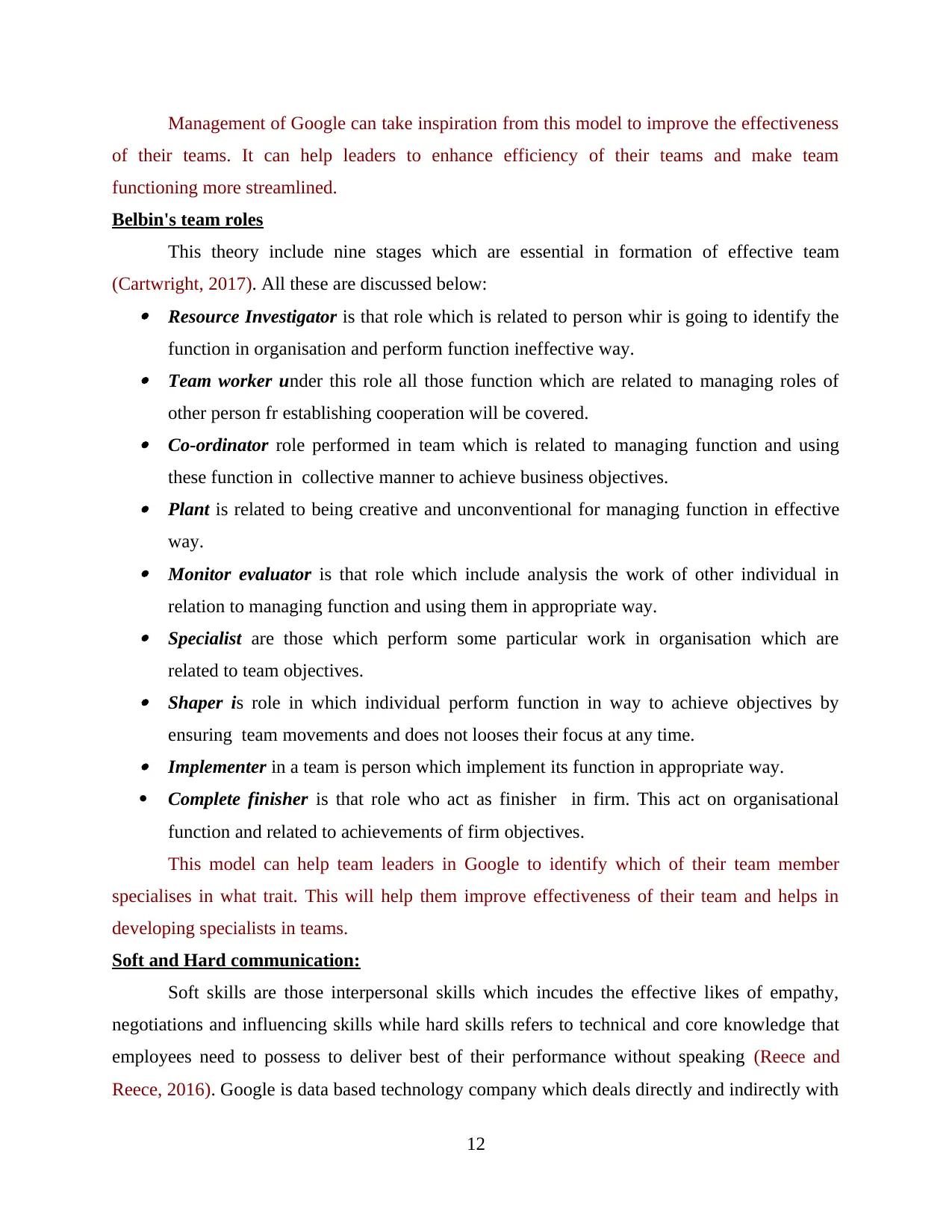
Management of Google can take inspiration from this model to improve the effectiveness
of their teams. It can help leaders to enhance efficiency of their teams and make team
functioning more streamlined.
Belbin's team roles
This theory include nine stages which are essential in formation of effective team
(Cartwright, 2017). All these are discussed below: Resource Investigator is that role which is related to person whir is going to identify the
function in organisation and perform function ineffective way. Team worker under this role all those function which are related to managing roles of
other person fr establishing cooperation will be covered. Co-ordinator role performed in team which is related to managing function and using
these function in collective manner to achieve business objectives. Plant is related to being creative and unconventional for managing function in effective
way. Monitor evaluator is that role which include analysis the work of other individual in
relation to managing function and using them in appropriate way. Specialist are those which perform some particular work in organisation which are
related to team objectives. Shaper is role in which individual perform function in way to achieve objectives by
ensuring team movements and does not looses their focus at any time. Implementer in a team is person which implement its function in appropriate way.
Complete finisher is that role who act as finisher in firm. This act on organisational
function and related to achievements of firm objectives.
This model can help team leaders in Google to identify which of their team member
specialises in what trait. This will help them improve effectiveness of their team and helps in
developing specialists in teams.
Soft and Hard communication:
Soft skills are those interpersonal skills which incudes the effective likes of empathy,
negotiations and influencing skills while hard skills refers to technical and core knowledge that
employees need to possess to deliver best of their performance without speaking (Reece and
Reece, 2016). Google is data based technology company which deals directly and indirectly with
12
of their teams. It can help leaders to enhance efficiency of their teams and make team
functioning more streamlined.
Belbin's team roles
This theory include nine stages which are essential in formation of effective team
(Cartwright, 2017). All these are discussed below: Resource Investigator is that role which is related to person whir is going to identify the
function in organisation and perform function ineffective way. Team worker under this role all those function which are related to managing roles of
other person fr establishing cooperation will be covered. Co-ordinator role performed in team which is related to managing function and using
these function in collective manner to achieve business objectives. Plant is related to being creative and unconventional for managing function in effective
way. Monitor evaluator is that role which include analysis the work of other individual in
relation to managing function and using them in appropriate way. Specialist are those which perform some particular work in organisation which are
related to team objectives. Shaper is role in which individual perform function in way to achieve objectives by
ensuring team movements and does not looses their focus at any time. Implementer in a team is person which implement its function in appropriate way.
Complete finisher is that role who act as finisher in firm. This act on organisational
function and related to achievements of firm objectives.
This model can help team leaders in Google to identify which of their team member
specialises in what trait. This will help them improve effectiveness of their team and helps in
developing specialists in teams.
Soft and Hard communication:
Soft skills are those interpersonal skills which incudes the effective likes of empathy,
negotiations and influencing skills while hard skills refers to technical and core knowledge that
employees need to possess to deliver best of their performance without speaking (Reece and
Reece, 2016). Google is data based technology company which deals directly and indirectly with
12
⊘ This is a preview!⊘
Do you want full access?
Subscribe today to unlock all pages.

Trusted by 1+ million students worldwide
1 out of 18
Related Documents
Your All-in-One AI-Powered Toolkit for Academic Success.
+13062052269
info@desklib.com
Available 24*7 on WhatsApp / Email
![[object Object]](/_next/static/media/star-bottom.7253800d.svg)
Unlock your academic potential
Copyright © 2020–2025 A2Z Services. All Rights Reserved. Developed and managed by ZUCOL.




